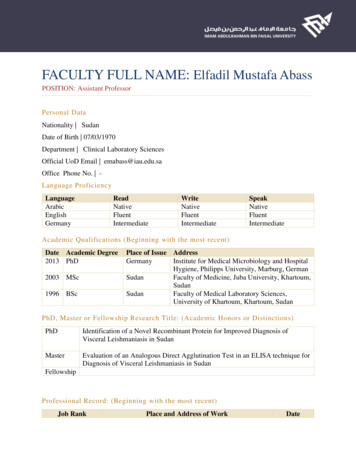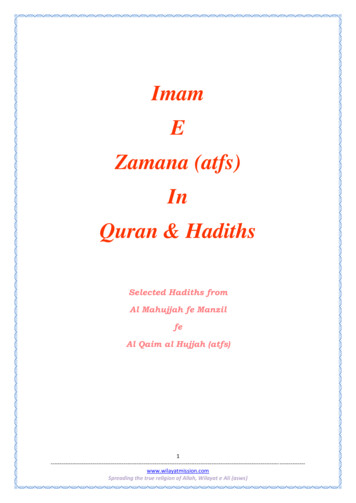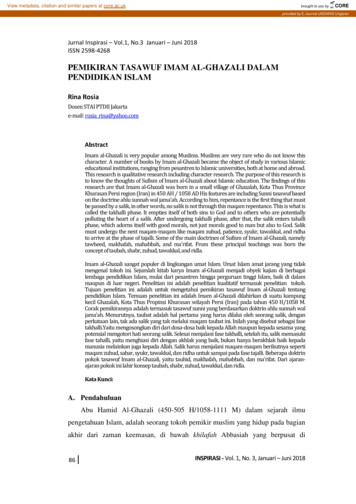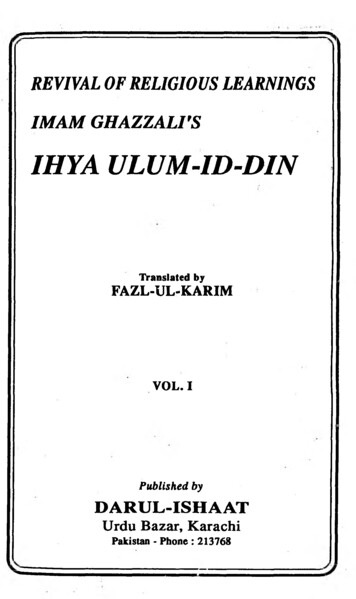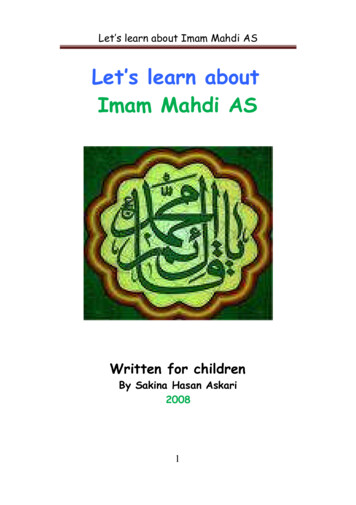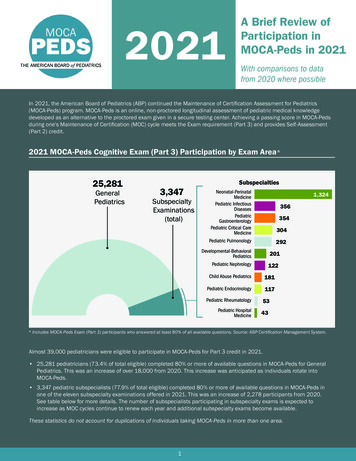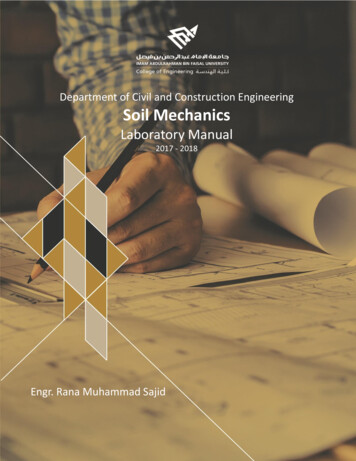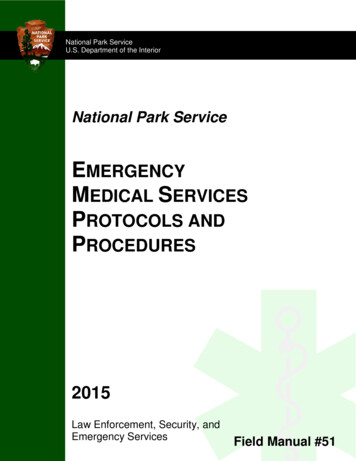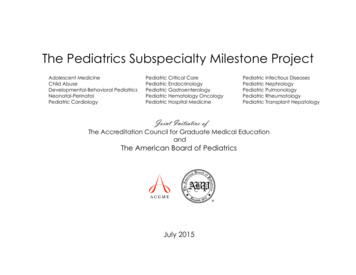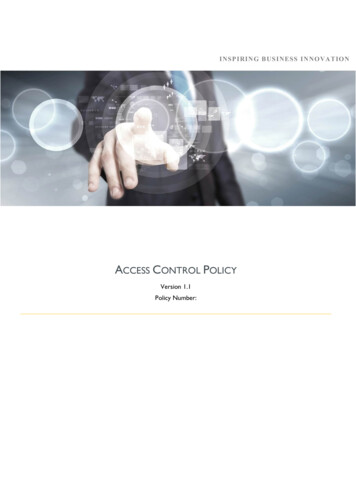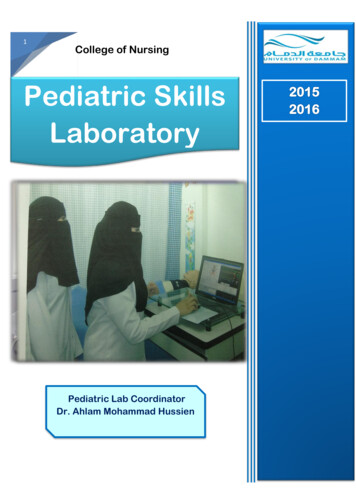
Transcription
1College of NursingPediatric SkillsLaboratoryPediatric Lab CoordinatorDr. Ahlam Mohammad Hussien
2Table of ContentsSection #Items1.Title Page2.Undergraduate Program Vision, Mission & Goals3.Pediatric Nursing Unit Vision and Mission4.Guidelines of Pediatric Nursing Skill Lab5.Goal & Philosophy6.Objectives7.Documents ( OSCE requirements , clinical rotation , first weekslab plan )8.Schedule of occupancy9.Lab Activities10.Pediatric Checklists11.Simulation lab Skill12.Assessment tool13.Pediatric Skill Lab Inventory
3
4Undergraduate Program Vision: To be an innovative cornerstone ofnursing education nationally, regionally; and internationally through the useof technology within a caring context.Undergraduate Program Mission: To offer dynamic, comprehensive andinnovative educational experience that will enable students to expand theirnursing knowledge and enhance their professional skills to meet the healthcare needs of the community within the context of Islamic culture, beliefsand values.Goals of the Program1. Provide quality education in nursing to graduate Saudi nurses withhigh scientific and clinical competencies.2. Utilize concepts from humanities and behavioural sciences in nursingpractice.3. Practice legal and ethical standards in nursing profession.4. Develop professional knowledge and practice through problem-solvingapproach and evidence-based learning.5. Utilize electronic administration and health information resources.6. Apply leadership and managerial skills to attain quality care.7. Focus on the commitment to the principle of “lifelong learning”.
5
6Vision and Mission of Pediatric Nursing UnitBased on the vision and mission of Nursing College, Dammam University, thevision and mission of Pediatric Nursing Department will be as follow:Vision:Providing the Saudi community with a high qualified professional nurses inpediatric care and who are unique on national and international levels. Sharingin an enhancement of children's health through the application of nursingeducation and researches in pediatric field.Mission:The pediatric nursing unit , college of nursing, university of Dammam (UOD)prepares the Saudi graduate and postgraduate candidates to be an competent,skillful and creative in delivering the needed nursing care for healthy and sickchildren from birth to adolescents in different pediatric settings. These arederived from recent national and international nursing strategies within theframework of Islamic belief and moral values.
7
8Lab GuidelinesThe pediatric nursing skills lab at the nursing college provides nursing studentswith an additional learning resource to meet their educational goals. The lab isequipped with instructional videos and DVDs, supplies and equipment, as wellas practice manikins including Baby sim Simulator, Pediatric manikins, CPRmanikins, Physical examination manikins, as well as high fidelity childsimulator. The lab provides students with a realistic, simulated clinicalenvironment to practice and demonstrate competency of selected nursingskills. Open lab times are posted at the beginning of each semester.Please keep in mind that the following guidelines should be followed duringyour attendance in the nursing skills open lab: No eating or drinking in the lab. Please turn your cell phone off or on vibrate before entering the lab. PLEASE clean up after yourself. Keep all beds in appropriate positions with linens straightened before leaving. Students are required to return clean equipment to its proper place after use. All simulated practice needles are to be disposed in sharps containers. Needles and syringes are not to be discarded in trash containers. If you are accidently stuck with a non-sterile needle or your skin comes incontact with contaminated material, you must immediately go to the LabCoordinator. Lab resource books, movies and supplies MUST NOT leave the lab. Please return all media to proper storage areas or to lab personnel after use. Please save equipment obtained in labs for practice during open lab times. Report any incidents or malfunctions to the Lab Coordinator immediately. Do not move mannequins. If a mannequin needs to be move contact labcoordinator. Keep personal belongings with you during the lab session, please take themwith you when leave.*If a latex or betadine allergy exists or is suspected, please notify your clinicalinstructor or lab coordinator.
9
10
11Newborn and pediatric Skill Laboratory“I hear, I forget; I see, I remember; I do, I understand” – ConfuciusGoalThe goal of the Pediatric Nursing Skills and Simulation Laboratory is topromote safe, knowledgeable and effective nursing care by demonstratingand reinforcing the highest level of performance and readiness.Introduction/PhilosophyThe Pediatric Nursing Skill and Simulation Laboratory is here to make thestudent’s clinical experience educational and enlightening and to promoteempowerment of the student. Scenarios and simulation experiences relate tothe pediatric nursing Lab objectives. Students will be oriented to simulationsinstructions prior to running a scenario. If the student is not comfortable,learning will not take place and scenario objectives may not be met.Simulations and case scenarios mimic the clinical setting and are designed tohelp the student develop problem-solving and decision-making skills.Simulations include all environmental factors to make students’ learningrealistic and authentic. These simulations help students think on their feetand help the transition from lab to clinical. For an enhanced learningexperience, students must come to the lab prepared. The faculty will providedebriefing and positive feedback; students will self-analyze theirperformance and use critical thinking during the reflection process.
12General InformationThe pediatric Nursing Skill and Simulation Laboratory is located inUniversity of Dammam, College of Nursing, C3. Room # has an InteractiveChild critical mannequin/Simulator (High Fidel Mity simulator), Infant Babysim Simulator. . The pediatric Skill Lab is fully equipped to practice allpediatric. nursing clinical skills served both undergraduate and postgraduatestudents. A variety of task trainers are also accessible as well as the ability toview a variety of media. Mentoring and tutoring are also available.The pediatric. Lab is opening 5 days a week (Sunday to Thursday) accordingto the students’ schedule and either they are undergraduate, post graduate &bridging students.The lab schedule is subjected to change:The calendar for the pediatric Nursing Skill and Simulation Laboratory isposted on pediatric lab. Bulletin.ConfidentialityAll simulation scenarios practice sessions involving students and/orrecordings are considered confidential. All mannequin accessibility shouldbe treated as a real patient (including inappropriate viewing). Discussion ofscenarios or information is considered a violation of Practical NursingProgram privacy policy. All students will need to sign a confidentiality labform.
13
14Pediatric Nursing (NURS: 1610-431)First Semester Academic Year 2015 – 2016Pediatric Lab unitClinical training in Pediatric Lab equips students with essential knowledge,skills, and attitude needed to provide accurate, safe, and comprehensivenursing care for normal child. Training in such fields of nursing enablesstudent to function within the framework of family centered care.Learning Objectives:At the end of this rotation the student nurse will be able to:1. Assess physical and behavioral states of child.2. Monitor and interpret vital signs.3. Measure weight, height as well as head and chest circumferences.4. Provide immediate and daily care for child.5. Apply the nursing process in caring for normal child.6. Assist in administration of medications via different routes.7. Follow the universal infection control precautions.8. Encourage mothers to breast feed whenever possible.9. Maintain optimal nutrition for children either enteral or parenteral.10.Encourage and facilitate parent child bonding.11.Asses and manage pain.12.Record and report any detected abnormality.13.Prepare parents for discharge and home care.
1514.Provide health education concerning child care & follow up15.Documents findings, nursing care & abnormalities
16
17Pediatric Nursing (NURS 1610-431)Frist Semester-4th Year/7th LevelAcademic Year 2015/2016-G (1436/1437-H)First four Weeks' Plan1st WeekDate/ TimeGroupLecture & ProceduresVenueTuesday.25/ 8/20151 –4 pmAll GroupsCourse Syllabus &Introduction to PediatricNursingHospitalBuilding ( B )F22 -23All GroupsIntroduction, principles&Factors affectingG&DAssessment of growth &Development and NewbornG&DGrowth and Developmentof infant and toddlerWednesday.26/ 8/20158 – 10 am10 – 12 pmStaff membersDr. Awatef El-SayedDr. Ahlam HussienDr. Laila Abu SalemC 1: (Class 5- 1)C 1: (Class 5- 1)Dr. Huda NafeeBreak12-1 pmG1, G2& G3Physical Assessment Part INewborn labMrs. Ibtihal AL moaminG4, G5 & G6Medication Part IPediatric labDr. Awatef El-Sayed1-3 pmThursday:27/8/20158-10 amAll Groups10 -12 pmAll Groups12-1 pmAll GroupsGrowth and developmentof Preschool, school andadolescent childrenRe-DemonstrationPhysical Assessment Part IMedication Part IC 1: (Class 5- 1)Dr. Awatef Al SayedNewborn labPediatric labAll StaffBreakG4, G5 & G6Physical Assessment Part INewborn labMrs. Ibtihal AL moaminG1, G2& G3Medication Part IPediatric labDr. Awatef El-Sayed1-3 pm.
182nd WeekDate/ TimeTuesday.1/ 9 /20151 - 4 pmWednesday.2/9/20158 – 11 am11 – 12 pmGroupLecture & ProcedureVenueStaffmembersAll GroupsFeeding of infants &ChildrenHospitalBuilding ( B )F22 -23Dr. Huda NafeeDr. Awatef ElSayedAll GroupsAssessment and managementof high risk neonates.C 1: (Class 5.1All GroupsRe-DemonstrationPhysical Assessment Part IMedication Part INewborn labPediatric labAll StaffNewborn labDr. Huda NafeePediatric labMrs. Ghada AlGhamdiBreak12-1 pmPhysical Assessment Part IIG1, G2& G31-3 pmMedication Part IIG4, G5 & G6Dr. AhlamThursday:3/9/20158 – 11 amAll Groups11 – 12 pmAll Groups12-1 pmCongenital AnomaliesRe-DemonstrationPhysical Assessment Part IIMedication Part IIC 1: (Class 51)HussienMiss.TahaniAL-ShammariNewborn labPediatric labAll StaffNewborn LabDr. Huda NafeePediatric LabMrs. Ghada AlGhamdiBreakG4, G5 & G6Physical Assessment Part II1-3 pmG1, G2& G3Medication Part II
193rd weekDate/ TimeTuesday.8/ 9 /20151 - 2 pm2- 4 pmWednesday.9/9/20158 - 12 amGroupVenueStaffmembersHospitalBuilding ( B )F22 -23Dr. Huda NafeeC 1: (Class 51)Dr. Laila AbuSalemCPR for InfantNewborn LabDr. Laila AbuSalemCPR for ChildrenPediatric LabMiss TahanyAl-ShemaryRespiratory disordersC 1: (Class51)Dr. LailaAbu-SalemNewborn LabPediatric LabAll StaffLecture & ProceduresQuiz1 All GroupsAll GroupsGastrointestinalDisordersCardiovascular disordersBreak12-1 pmG1, G2 & G31-3 pmG4,G5 & G6Thursday:10/9/20158 – 11 amAll Groups11 – 12 PmAll GroupsRe-DemonstrationCPR for ChildrenCPR for InfantBreak12-1 pmG4,G5 & G6CPR for InfantNewborn LabDr. Laila AbuSalemCPR for ChildrenPediatric LabMiss TahanyAl-Shemary1-3 pm.G1, G2& G3
204thweekDate/ TimeTuesday.15/ 9 /20151 - 4 pmWednesday.16/9/20158 – 11 am11 – 12 pmGroupAll GroupsLecture &ProceduresNutritional disordersVenueStaffmembersHospitalBuilding ( B )F22 -23Dr. Huda NafeeAll GroupsHematological disordersC 1: (Class51)Dr. Laila AbuSalemAll GroupsRe – demonstrationCPR for ChildrenCPR for InfantNewborn LabPediatric LabAll StaffNewborn LabDr. SanaaGhareeb &Mrs. HananAbu GurainPediatric LabMiss TahanyAl-ShemaryC 1: (Class51)Dr. Awatef ElSayedC 1: (Class 51)All StaffNewborn LabDr. SanaaGhareebMrs. Hanan AbuGurainPediatric LabMiss TahanyAl-ShemaryBreak12-1 pmG1, G2& G3Suctioning & OxygenTherapy1-3 pmG4,G5 & G6Thursday:17/9/20158 – 10 am10 – 12 pmAll GroupsAll GroupsGavage Feeding & bottlefeedingUrinary tract DisordersRe-demonstrationSuctioning & OxygenTherapyGavage Feeding & bottlefeedingBreak12-1 pm.G4,G5 & G6Suctioning & OxygenTherapyG1, G2& G3Gavage Feeding & bottlefeeding1-3 pm.
21
22PEDIATRIC NURSING (NURS 1610- 431)1st Semester- 4th Year/ 7th LevelAcademic Year 2015/2016-G (1436/1437-H)Simulation and skills lab rotation planTimeExperienceo08001200Skills labooooo1200010001000300DetailsDay 1Nebulizer medicationadministration.NG and bottled feeding.O2 administration andsuction.IM medicationadministrationIV iatriclab/NewbornLabMrs. GhadaAL-GhamdiBreakSimulationBronchial Asthma and Shock overview/DemonstrationNewbornLabMrs. GhadaAL-GhamdiDay ionBronchial Asthma Simulation and DebriefingCC1Shock SimulationNewbornLabMrs. GhadaAL-GhamdiBreakSimulationCont. Shock Simulation and DebriefingNewbornLabMrs. GhadaAL-GhamdiDay 30800100010001200Skill labSkill lab evaluationSkill LabSimulation ediatricLab/NewbornLabMrs. GhadaAL-GhamdiMrs. GhadaAL-GhamdiBreakSimulationSimulation EvaluationPediatricLab/NewbornLabMrs. GhadaAL-Ghamdi
23College of NursingPediatric Nursing (NURS 1610-431)First Semester AY 2014-2015First Two Weeks' Plan1st WeekDate/TimeGroupProcedureVenueStaff membersWed.3/9/20148 - 10 amAll GroupsCourse Syllabus &Introduction to PediatricNursingC2: Class 4Dr. Magda EssawyDr. Awatef El-SayedG1, G2& G3Physical Assessment Part IC2: Class 4Dr. Huda NafeeG4, G5 & G6Medication Part IC3: Blue hallDr. Awatef El-Sayed10-12 am.Break12-1 pm.G1, G2& G3Physical Assessment Part IIC2: Class 4Dr. Magda EssawyG4, G5 & G6Medication Part IIC3: Blue hallMrs. Juliet1-3 pm.3 – 4 pm.Thursday:4/9/20148-10 am.Re-demonstrationAll clinical staffG4, G5 & G6Physical Assessment Part IC2: Class 4Dr. Huda NafeeG1, G2& G3Medication Part IC3: Blue hallDr. Awatef El-SayedG4, G5 & G6Physical Assessment Part IIC2: Class 4Dr. Magda EssawyG1, G2& G3Medication Part IIC3: Blue hallMrs. Juliet10-12 am.Break12-1 pm1-2 pm.2-5 pmRe-demonstrationAll GroupsTheoryAll clinical staffC2: Class 4Dr. Awatif El Said
242nd WeekProcedureVenueStaffmembersCPR for InfantNewborn LabDr. Laila AbuSalemCPR for ChildrenPediatric LabMiss TahanyAl-ShemaryGavage FeedingOBG. LabDr. YousrGaafarDate/ TimeGroupWed. 10/9/20148 - 9 am9 – 10 am10-11 am8 - 9 am9 – 10 am10-11 am8 - 9 am9 – 10 am10-11 amG1 & G2G3 & G4G5 & G6G3 & G4G5 & G6G1 & G2G5 & G6G1 & G2G3 & G411-12 am.All GroupsRe-demonstrationBreak12-1 pm1-4 pm.All clinical staffAll GroupsTheoryC2: Class 4Dr. YousrGaafarNewborn LabFathia AlSomaly &Ghada AlGhamdyPediatric LabLatifaAlDossary &Ebtihal AlMoamenThursday:11/9/20148 –9.30 am9.30 – 11 amG1, G2& G3G4,G5 & G68 –9.30 am9.30 – 11 amG4,G5 & G6G1, G2& G3Restraint11-12 am.All GroupsRe-demonstrationSuctioning & Oxygen TherapyAll clinical staffBreak12-1 pm.1-2 pm.All GroupsRe-demonstration2-5 pm.All GroupsTheoryAll clinical staffC2: Class 4Dr. YousrGaafar
25Pediatric Nursing (NURS: 1610-431)First Semester Academic Year 2014 - 2015
26Pediatric nursing, 2014-2015Summary of OSCE for pediatric nursing:* OSCE will be done in one day schedule staring from 8.30 am up to2.30 pm, on Wednesday 24-12-2014.* Three nursing labs will be used in OSCE exam, newborn, infant & childrenand simulation lab. Four stations will be prepared in each lab and 5 minuteswill be allowed for each station.* Students will be divided into nine groups 12 students for each (totalstudents No. is 95).* OSCE will be carried out in eight cycles, each cycle will consist of 12students (4 students in each lab), every student will get 5 stations as a hall(two stations in newborn lab, two stations in infant & children lab and onestation in simulation lab) , each station will consume 5 minutes.5- If students require assistance or need a bathroom, please inform theinstructor.6-At the end of exam, student will move to a classroom and please, avoidcontacting with other students.
27Preparation of OSCE exam, pediatric nursing:Three nursing labs will be used in OSCE exam, newborn, infant & childrenand simulation lab. Four stations will be prepared in each lab, the clinicalexam will be done in one day schedule staring from 8.30 am up to 2.30 pm,students will be divided into eight group’s 12 students for each (totalstudents No. is 95). The distribution of stations will be as following:Nursing labsStaff membersNewborn lab:Stations one & two:estimation of gestational ageStations Three & four:Bottle feedingDr. Laila Younis &Mrs. Fathia Al SomaliDr. Yousr Gaafer &Dr. Moma GamalInfant & children lab:Stations one & two:TraigeStations three & four:Congenital anomalies photosDr. Awatif El SaidDr. Hoda Nafa &Dr.Ahlam Hussen &Mrs. Ebtihal Al MoamenSimulation lab:Stations one & two:Bronchial asthma scenarioDr. Magda Essawy,Mrs Tahany Al Shemery &Mrs Ghada Al Dossary
28Students Organizers:1.2.3.4.General students organizer, Dr. Magda EssawyTime keeper , Mrs rabhaa & Miss AnoodStudents in classroom, Dr. JulyStudent’s attendance and student’s simulation lab organizerMrs. Hellen.5. Student’s organizer for newborn lab, Mrs Zenab.6. Students organizer for infant & children lab Mrs. SamiaPoints should be considered in performing the pediatric OSCE1- Every student will get 5 stations as a hall (two stations in newborn lab,two stations in infant & children lab and one station in simulation lab), eachStation will consume 5 minutes.2- Mobile phones, printed or written materials are not allowed during theexam.3- Bell ring signal will be done on the beginning of the OSCE, on the startingand ending of each station.4- After finishing two stations from each lab, the student will move to thenext lab according to the preset map.Map of student’s movement in each cycle:* Starting in newborn lab* Starting in simulationinfant& children labnewborn lab* Starting in infant& children labsimulation labsimulation labinfant& children labnewborn lab
29
30Occupancy of Pediatric Nursing Lab in the1st Semester of Academic reakMedical&Surgical NursingMondayMedicalBreak&Surgical NursingTuesdayMaintenanceWednesday Pediatric Nursing Break1:00-3:00Medical &SurgicalNursingMedical &SurgicalNursingPediatric NursingHealth Assessment ( Bridging course)3pm-6:30pmThursdayPediatric Nursing BreakPediatric NursingClinical skill laboratories Coordinator /Dr. Radwa Hamdi BakrCoordinator of Pediatric Nursing Lab/Dr. Ahlam hussienPediatric Nursing Lab Manager/ Mrs. Sara Al abdali
31
32Report about workshop for how to conductCAE BabySim in Newborn labDate / 5 May 2015Venue/Newborn labAttendants:1-Dr. Magda Essawy.2-Dr.Ahlam Hussien.3-Dr. Laila Abu Salem.4-Dr.Awatef Al Sayed.5- Hoda Nafee6- Mrs. Liali7- Mrs. Ghada al Ghamdi*Engineer Wael from Eman Health Care Company cameto conduct a training on how to handle and maintain theBabySim SCE developmental software.
33
34PEDIATRIC NURSING (NURS 1610- 431)1st Semester- 4th Year/ 7th LevelAcademic Year 2015/2016-G (1436/1437-H)Body Temperature Measurement Check ListDate: Student'sName:ID#: Group# Rotation#:Steps of the Procedure1-Wash hands.2-Explain the procedure to the child or to his parents.3-Check thermometer to see the reading.4-Clean thermometer from tip to the bulb.5-Shake the level of mercury down to below 35 C.Oral Temperature:6-Place thermometer in the mouth far back under the tongue.7-Tell the child to keep mouth closed, breath through the noseand not to talk.8-Hold thermometer in place for 3 minutes.Remove thermometer and wipe it from up down to the bulbRectal temperature:9-Rinse and dry the anal area.10-Lubricate the bulb of the rectal thermometer.11-Place child in side-lying or prone position.12-Place infant prone across mother’s lap or supine with kneeflexed toward abdomenDonecomplete( 2)Doneincomplete ( 1)Not done( 0)
3513-Insert the lubricated thermometer 2.5 cm in the rectum andhold it for one minute.14-Remove the thermometer and wipe with swab from up downto the bulb.15-Take the reading.16-Wash thermometer with soap and water and disinfectant.Axillary temperature:17-Rinse and dry axilla.18-Place thermometer under arm with tip in center of axilla andkeep it close to skin not clothing.19-Hold child’s arm firmly against side for 5 minutes.20-Remove thermometer and wipe it from up down to the bulb.Total marksSignature of faculty member:Date:/ out of 40
36Heart rate Measurement Check ListDate: Student'sName:ID#: Group# Rotation#:Steps of the procedureDonecomplete(2)1- Hand washing.2-Explain the procedure to the child and infant’s family.3-Wipe earpieces and diaphragm with alcohol swabs.4-Expose the chest over the apex of the heart.5-Wipe earpieces and diaphragm of stethoscopealcohol swab.with6-Place the stethoscope between the fourth and the fifthintercostal spaces just below the left nipple.7-Listen to the heart sound and count for one full minute.8-Wipe the earpieces and the diaphragm with alcohol swabTotal marksSignature of faculty member:Date:/ out of 16Doneincomplete(1)Notdone(0)
37Respiratory Rate Measurement Check ListDate: Student'sName:ID#: Group# Rotation#:Steps of the ProcedureDonecomplete(2)1- Expose the chest.2-Observe abdominal movement in infants & young children3- Observe thoracic movement in older children.4-Count respiration for one full minute.5-Report any abnormalityTotal marksSignature of faculty member:Date:/ out of 10Doneincomplete(1)Not done( 0)
38Blood Pressure Measurement Check ListDate: Student'sName:ID#: Group# Rotation#:Steps of the ProcedurePreparation:1- Select the appropriate cuff size.2-Attach the tube from the BP cuff.3-Open the cock.5-Close the valve of bulb.Procedure:6-Expose the upper arm.7-Apply the cuff evenly over the upper arm with the loweredge about 1.5 cm above the antecubital space8-Position the sphygmomanometer on a level surface atapproximately the level of heart.9- Palpate the radial artery and inflate the cuff until thepalpated pulse is lost then pump for additional 20 mmhg.10-Position the bell of the stethoscope over the area wherethe brachial pulse is felt.11- Slowly deflate the cuff and listen to the sounds.12- Deflate the bp cuff & remove it.13- Record the reading & report for any abnormality.Total marksSignature of faculty member:Date :/ out of 26Donecomplete(2)Doneincomplete ( 1 )Not done(0)
39Chest Circumference Measurement Check ListDate: Student'sName:ID#: Group# Rotation#:Steps of the Procedure1. Remove infant’s clothes of upper half.2.Place on a flat table in supine position.3. Place tape across the nipple line.4 Measure mid way between inspiration and expiration.5. Record.Total marksSignature of faculty member:Date:/ out of 10Donecomplete(2)Doneincomplete ( 1 )Not done(0)
40Height Measurement Check ListDate: Student'sName:ID#: Group# Rotation#:Steps of the Procedure1-Remove the child’s shoes and socks2-Stand as tall and straight as possible with head in midlineand the line of vision parallel to the floor.3-The child’s back should be to the vertical flat surfacewith heels, buttocks and back of the shoulder touching thesurface.4-Any flexion of the knees, lumping of the shoulders orraising of heels of the feet is checked and corrected.5-Move the board on the top of the head.6- Read and record.Height “using measuring tape”7-Attach a measuring tape to the wall.8-Place the child adjacent to the tape.9- Place a three dimensional object, such as thick book orbox on the tape of the head.10-The side of the book must rest firmly against the wall toform a right angle.11-Length or stature is measure to the nearest 1 ml.12-Record.Total marksSignature of faculty member:Date:/ out of 24Donecomplete ( 2)Doneincomplete ( 1 )Notdone ( 0)
41Length Measurement Check ListDate: Student'sName:ID#: Group# Rotation#:Steps of the Procedure1- Place the towel on the board.2- Remove the infant clothing.3- Place infant on center of board firmly in supine position.4-Hold the head against headboard firmly.5-Grasp the knees together gently.6-Push down in knees until the legs are fully extended &hold thelegs firmly.7-Bring the headboard against the soles of heals firmly.8- Read and record.Length “using measuring tape”9-Place the infant on a proper covered hard surface.10-Push down the knees and head against a firm surface.11-Make points of the top of the head and heel of the feet by apoint.12-Remove infant from his place.13-Measure between these two points.14-Record.Total marksSignature of faculty member:Date:/ out of 28Donecomplete ( 2)Doneincomplete ( 1 )Not done(0)
42Weight Measurement Check ListDate: Student'sName:ID#: Group# Rotation#:Steps of the Procedure1-Place the scale horizontally.2- Check to see that scale is balanced by sitting it to the zero, andnoting if the balance registers exactly in the middle of the mark.3-Make the patient room warm.4-Wipe the scale with cotton with alcohol.5-Remove the infant clothing.6-Put a scale paper on the scale.7-Gently lift the infant from the bed and place him in the scale basket.8- hold hand over the body of the infant for safety,9-Adjust the weight to balance the scale by right hand.10-Read the scale when infant is lying still.11-Remove and dispose the scale paper.12-Record the weight.Weight “for older children”13-Balance the scale.14-Place a paper towel on the scale for the child to stand on.15- Keep child privacy.16-Child usually weighed while wearing their underpants or light gown.17-Remove shoes of the child.DonecompDone incomp.(2)(1)Not done( 0)
4318- Read and record.Total marksSignature of faculty member:Date :/ out of 36
44Physical Assessment Check ListDate: Student's Name :ID#: Group# Rotation#:Steps of the Procedure1.History Taking:Biographic data.Chief complaint.Present illness.Past health history.Family health history.Previous hospitalization.Immunization received.Feeding patternAllergies.Activity pattern.2.Growth Measurement:Length / height.Weight.Head circumference.Chest circumference.Arm circumference.3.Physiological Measurement:Temperature.Pulse.Respiration.Blood pressure.4.General Appearance: Inspect for:Posture.Facial expression.Hygiene.Nutritional status.Level of child activity.Child’s reaction to stress.5.Skin:Inspect color.Palpate texture.Palpate Turgor.Donecomplete ( 2 )Done Notincomp donelete ( 1) (0)
45Lymph nodes. Inspect & palpate.SizeTemperature.TendernessAny abnormality.6.Head: Inspect:Shape.Control.Posture.Inspect and palpate:FontanelsExamine: range of motion7.Scalp:Inspect & palpate:Cleanliness.Trauma.LesionsHair texture.Hair loss.Hair discoloration8.Face:Inspect - symmetry.- Facial.Expression9.Neck:Inspect - Size- Trachea.- Thyroid- Carotid arteriesPalpate thyroid glands.10.Eyes:Test visual activity.Inspect - Placement.- Lids.- Conjunctiva.- Eyelashes.- Eye brows.- Cornea.
46- Pupils.- Iris.- Lens.Examine – pupilsReaction to light.11.Ears:Inspect- PinnaExternal canal.12.Nose & Sinuses:Inspect - External nose.Nasal mucosaNasal septum.Palpate - Sinuses for tenderness.13.Mouth and Tthroat:Inspect- Lips-PharynxTongue. GumsTeethRoof of mouth- color - exudate - tonsils14- Chest:Inspect chestPalpate chest.Percuss chest.Ansultate the chest.15- Nails: Finger nails and toes nails.Inspect for color and shapePalpate for lesions.16- Heart:Inspect heart.Palpate for:PulseTactile fremitus.Auscultate for heart sounds (S1 / S2).17- Back:
47Inspect back for:ColorSymmetry.Lesions.Palpate back for lesions.18- Genitalia:Male: Inspect and palpate:PenisScrotumTestsFemale: Inspect:LabiasUrethral meatusUrethral meatusVaginal orifice19- Anus:Inspect:- OpeningSkin condition.20- Extremities:Range of motionInspect: Upper and lower extremities for:ColorSymmetryLesionsBowlegs / knock knee.Palpate:PulseOedema- Lesions21- Neuromascular system:Test for:Activity – mobilityLevel of consciousnessReflexesSensationTotal marksSignature of faculty member:Date :/ out of 42
48Formula Preparation ChecklistDate: Student'sName:ID#: Group# Rotation#:Steps of the procedureDoneDonecomplete incomplete(2)(1)1- Wash all utensils used for bottle feeding with warm soapy water.2- Rinse with running water3- Place all equipment except rubber articles in a covered container,boil for 10 minutes. the rubber teats should be boiled for 3 minutes4- Wash hands5- Boil in the kettle fresh water and pour it into the graduated bottle6- Leave the water to cool6- Loosely fill the scoop with milk powder after checking the expirydate on the formula tin7- Add scoops of powder to the bottle of cooled boiled water.8- Seal the bottle with the disc, screw ring and cap then shake the bottleto dissolve the milk powder.9- Change the infant diaper10-Check the temperature of the milk feed by dropping a few drops onto the inside of your wrist11-A plastic apron may be worn12-Infant should wear a bib13-The care giver should sit down in a comfortable chair with theinfant's head supported in the upright position.14-Tilt bottle to keep the nipple full at all times.15-Stimulate rooting reflex by rubbing nipple along lower lip ortickling side of cheek.16-Place nipple on top of tongue17-After 5 minutes, stop feeding and burp infant by placing over theshoulder and moderately patting the infant's back with a cupped hand18-Burp infant again at the end of feeding19-Place infant in safe and secure supine position in the crib orbassinet.20-Discard bottle and formula remaining in bottle at the end of feeding21-Hand washing22-Record: time, type, and amount of fed as well as problemsencounteredTotal marks :out of / 44Signature of faculty member:Date:Notdone( 0)
49Nasogastrlc Tube Feeding ChecklistDate: Student'
G4, G5 & G6 Medication Part I Pediatric lab Dr. Awatef El-Sayed C 1: (Class 5- 1) Dr. Awatef Al Sayed Growth and development of Preschool, school and adolescent children All Groups Thursday: 27/8/2015 8-10 am All Staff Newborn lab Pediatric lab Re-Demonstration Physical Assessment Part I .

